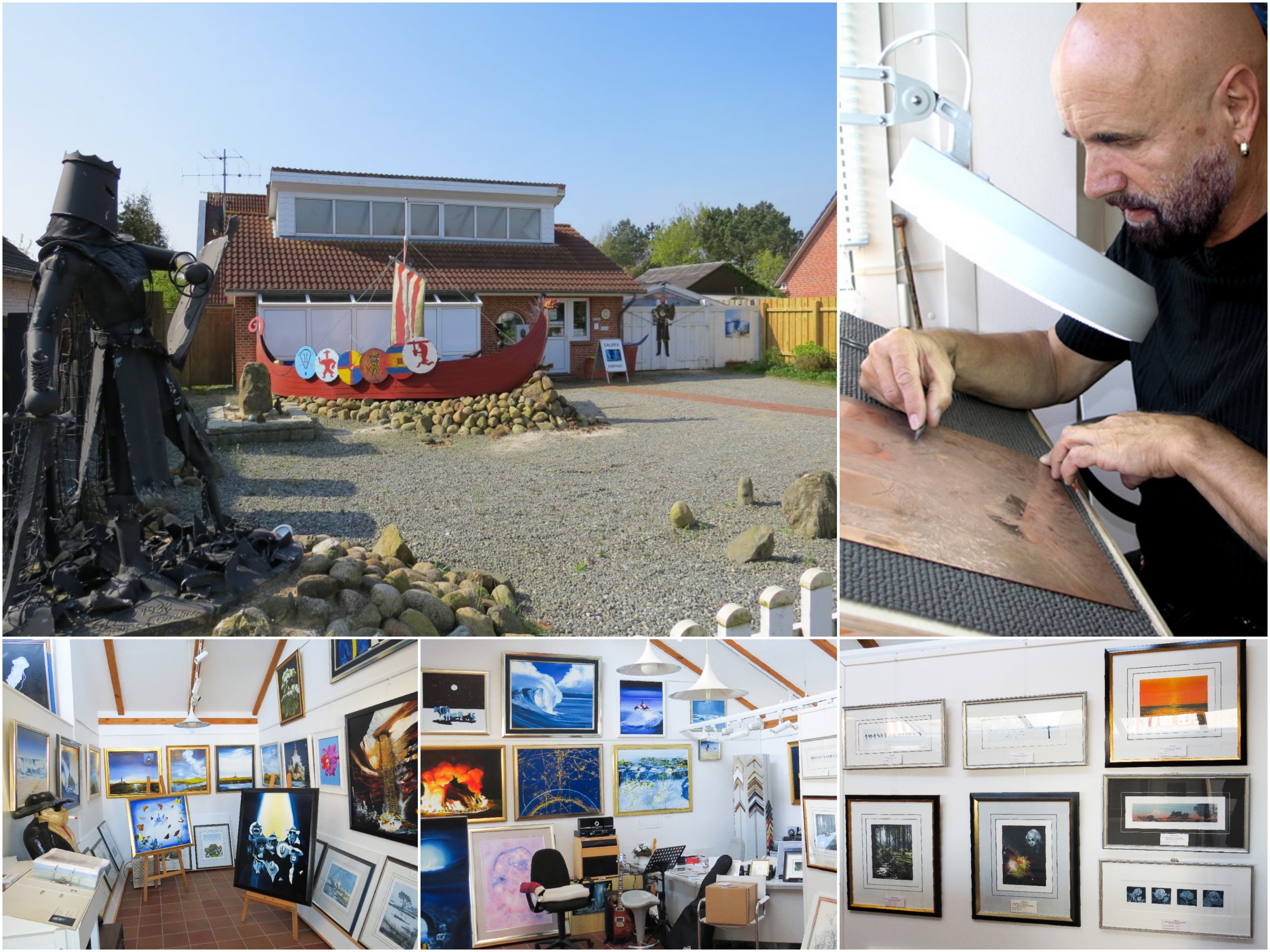In our gallery in the Bövergeest you are very welcome. In this brightly lightened room you will only discover works of mine exclusively. External galleries do not have my works.

It is a good idea to make a reservation by calling the number 0049-4863-3086 before your visit, or you can just take a chance and drop by. If you have never entered my gallery before, you will find that there is a relaxed atmosphere in our rooms.
You won´t have the feeling of having to buy something. Good mood on your part and the willingness of my wife Ingrid and me to lead a nice conversation is something we take for granted. If you have technical questions, such as “How do you make a mezzotint plate”, I am gladly at your disposal as an artist. Please take into account that this can only be explained to a limited extent, as the period for this has to be restricted. Nevertheless you will be sufficiently informed. In such cases I presume your understanding. My major events “How to create an etching/copper engraving”, which I have done once a week in schools, museums and in my studio for over 30 years, are over now.
You can view or purchase my works such as color engravings and copper engravings, drawings, watercolors, pencil drawings, oil paintings and much more. The exhibition in my gallery is changing constantly, which accounts for the special appeal when you visit several times. We are delighted to welcome visitors who are interested in art as well as closer friends, often former customers that feel connected to my work. My wife is a lot better than me at many things. Often I am in danger of talking too much making some visitors happy and others not. I personally enjoy a lot when small children, for example the preschool children of our local kindergarden, ask questions – questions that are never ambiguous, but always open and honest. These encounters are a real therapy for me. “If you have your childhood with you, you will not get older”, said Goethe.
Glossary
Here, materials that are otherwise used alone for the completion of a picture can be combined or mixed. The surface, such as cardboard, paper or wood, is left to the artist and depends on, among other things, the materials to be applied. The artist decides all by himself. The advantage of such work allows the artist to create unusual structures by mixing or juxtaposing different substances, which then have to produce both color and formal characteristics. Wanted or unwanted contrasts can arise here for the work, for example materials that repel or intermingle.
1. Sheets with the designation E. A. or Epreuve d’Artiste: These prints, which are often falsely referred to as proof prints, are here to name prints which the artist makes for his own use. Usually this is up to 25 pieces. The term “h.c. “(hors de commerce).
2. Sample prints: These prints, also known as Epreuve d’Etat, are state prints prior to completion of the printing form, which the artist makes during his work for the control. The unfinished parts of the picture are characteristic. Such objects, of course, are very rare, and the older and more famous the artist, the more coveted.
3. Working conditions from the finished plate (etats): The etching is suitable for the artist working on the plate after the first printing; he can cover, etch, work with a hard-pointed needle, or – as Rembrandt had done in almost all his works in etching – insert new parts and omit existing ones.
1. It is the exclusive right of the artist to establish the definite number of copies of each of his graphic works in the various techniques, such as copper engraving, etching, lithography, etc.
2. In order to be regarded as the original, each print must bear the signature of the artist as well as a numbering showing both the serial number of the individual print and the total number of impressions in that particular edition.
3. The above-mentioned principles relate to graphical works, i.e. to prints the artist made on an original plate, the woodcut, the stone, or a corresponding other material. Works which do not fulfill these conditions must be regarded as reproductions.
We call originality in art a property: it denotes the authenticity of a work – an artist has created it by hand, from the idea to the finished realization, so it originates (lat. origo = origin, origin) only from him. It is not a copy, but can very well be a replica, i.e. a repetition. Not the unique, not the number, but the authenticity decides. Such questions of originality must be distinguished very clearly from “originality”, which is about the peculiarity in the sense of a novelty.
The printmaking process includes all those processes in which impressions are produced from a plate (copper/steel). This is accomplished through depression in the form of lines, dots oder areas, which are formed in the surface of a polished metal plate. These depressions or grooves, in turn, are filled with ink; handmade paper is forced into the depressions by pressing. If you take a not engraved plate, ink it all over and let it run through a printing press, you get a blind print. If, however, the plate is scraped, pricked or etched, and then carefully inked, the ink only fills the depressions of the plate. This is the visible print then. This process requires years of experience and great craftsmanship. However, the techniques required to form the depressions in the surface of the plate are varied. For example:
- copper engraving
- line etching
- drypoint
- vernis mou (soft ground etching)
- aquatint
- mezzotint
- stipple engraving
- reservage
- deep etching



